
- Source: BLOUIN ARTINFO
- Author: ROZALIA JOVANOVIC
- Date: BLOUIN ARTINFO
- Format: AUGUST 8, 2013
Luxembourg & Dayan Spin-Off OKO Gallery Features Mind-Altering Hoagie

Alex Da Corte and Borna Sammak, "As Is Wet Hoagie"
(Courtesy of Oko)
False eyelashes, smashed cellphones, and an individually wrapped pickle are all things seemingly for sale at a storefront in the East Village. Though the display beckons with illuminated neon signs that say “Hoagie” and “Hell Here,” the interior is otherwise dark. Peering in from the outer window is a mind-bending experience. Inside the space, there are two more storefronts, one behind another behind another — brick façade, window crammed with junk, and all. Beyond the final door we can catch a glimpse of a room with red-and-white diagonally striped wall paper, and on a low platform an enormous hoagie sandwich.
Nothing here is in fact for sale at this many-layered storefront, except the whole assemblage itself. It is an installation called “As Is Wet Hoagie,” by artists Alex Da Corte and Borna Sammak at OKO Gallery, a tiny space that is the grittier younger sister to the Upper East Side powerhouse Luxembourg & Dayan. And though the installation went up on July 13, the gallery door is currently locked and it can only be seen from the street until August 22, when its door will open at last.
Though the shop has only been up for a few weeks, it has already caused a lot of confusion in the neighborhood. “Some people come in asking for sandwiches,” Sammak told ARTINFO on our recent trip down to OKO Gallery. “Others think it’s a t-shirt shop.” We were standing on the front stoop where, as if on cue, a man walked across the street and looked into the doorway curiously and asked what it was (“Is this a sandwich shop? A gallery?”), and when told it was a gallery walked away uttering, “cool” and “great stuff.”
Ideally meant to be viewed from the outside, the show with its multiple windows crammed with odd items riffs on the way bodega environments accumulate mass, have inconsistent narratives, and serve a variety of needs within a given community. “It’s not about beauty as much as it’s about convenience,” said Da Corte, “trying to understand what starts a deli that sells guns on the side, or knives on the side. How do these things grow?”
For Sammak, the deli is akin to a friend you see out of convenience. “You hang out with people who are within a few blocks of you,” he said, “even though there might be someone you like better in Prospect Heights who you never see. A deli is the same way, except it’s a friend you don’t trust.”
The giant hoagie at the back of the store is both a humble personal keepsake — both artists are from Philadelphia where hoagies and cheesesteaks are the source of great local pride — and a symbol of a mythical ideal. “It’s like the Sword in the Stone,” said Da Corte. “It’s about legend, or heroism, or sex.” The piece grew out of an episode of the Simpsons in which Homer sees the world’s biggest sandwich, a 10foot hoagie, that he tries to finish but can’t. He takes it home, stores it behind the radiator until it turns grey, and eats it intermittently until it makes him ill. “For Homer, it became this desire to do it out of principle,” said Da Corte. “That in itself becomes like a kind of hero-quest.”

The chaotic, vibrant nature of the show follows the spirit of a line of idiosyncratic exhibitions — including Julian Schnabel and Dan Colen — that have come before it at the gallery since it launched in 2012. OKO’s curator, Alison Gingeras, has planned it that way to ensure that they resonate with the eclectic vibe of the neighborhood (the space that OKO gallery now fills was formerly a vintage jewelry store called Magic Fingers). As per Gingeras’ dictum, the Schnabel exhibition, showed four works, from 1978 — 1981, but one at a time.
Though “As Is Wet Hoagie” has existed in its closed form since July 13, it is still a work in progress. And when it’s done the entire thing will be for sale (for roughly $40,000, with the hoagies for sale as editions). But its prolonged opening, which will happen with no more fanfare than the unlocking of the front door, is not the only oddly timed event in the life of the exhibition. On September 12, less than a month after it opens, the gallery will host a “finissage,” or closing party, which is a holdover from curator Gingeras’s time in Paris where it was “a big thing that people would do, especially when you would make something really special.” She also wanted to do away with “that whole postpartum depression” that artists contend with after they’ve finished a show. “It’s nice to finish a show with a bang.”

